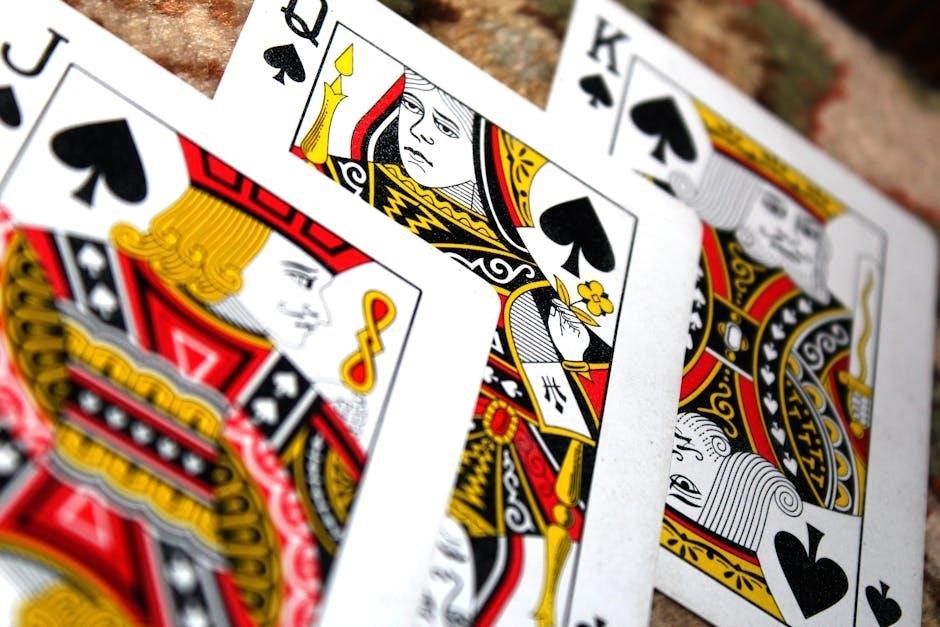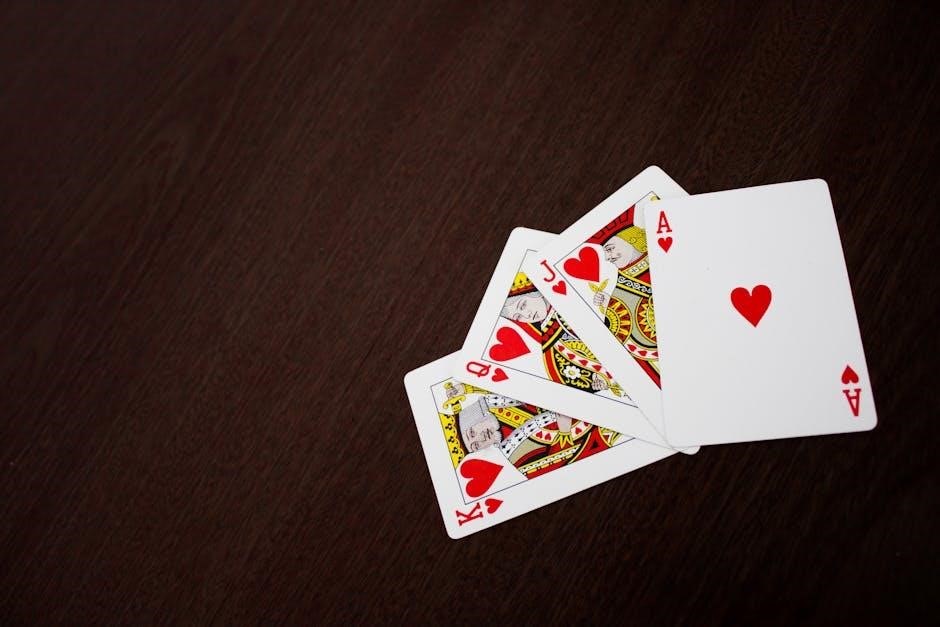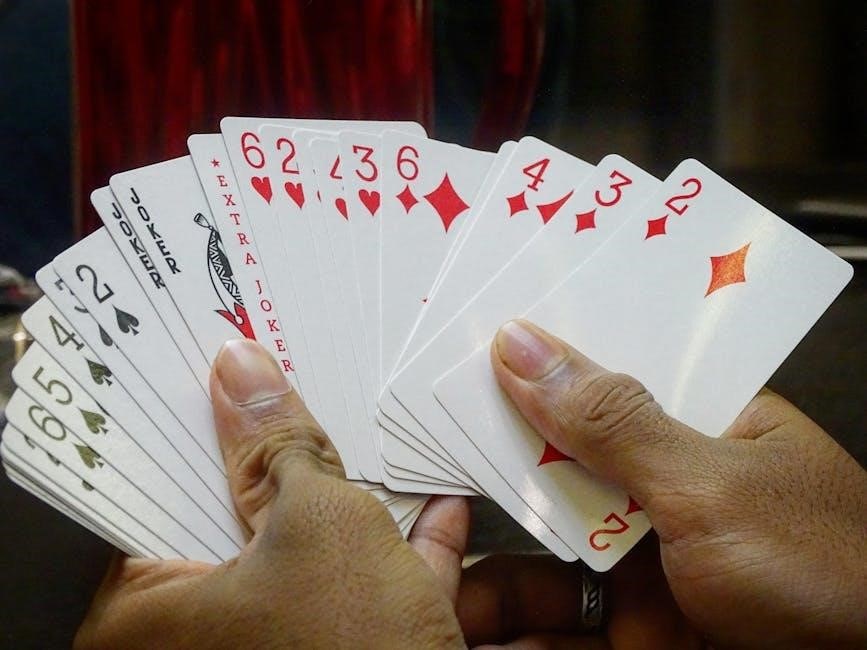Hand and Foot is a popular card game, often compared to Canasta, played with multiple decks and jokers. The goal is to discard all cards first, starting with the hand and then the foot. It involves strategy and teamwork, typically played in partnerships. The game is known for its engaging gameplay and customizable rules, making it a favorite among card enthusiasts.
Overview of the Game
Hand and Foot is a popular, engaging card game that combines strategy and teamwork, often compared to Canasta. Played with multiple decks and jokers, it involves forming valid card combinations called melds. The game is typically played in teams, with 4 to 6 players, and involves both a “hand” and a “foot” pile of cards. Players aim to be the first to discard all their cards, starting with the hand and then the foot. The game is known for its dynamic gameplay, use of wild cards, and the ability to customize rules, making it adaptable to different player preferences. Its structure allows for both casual and competitive play, appealing to a wide range of card game enthusiasts.
Popularity and Variations
Hand and Foot is a beloved card game, especially in North America, due to its engaging gameplay and adaptability. Its popularity stems from its similarity to Canasta, with variations allowing for flexibility in play. The game is enjoyed by 4 to 6 players, often in teams, and can be customized to suit different group sizes and preferences. Variations include the number of decks used, with 4 players using 6 decks and 6 players requiring 7. Additionally, house rules and scoring systems can vary, allowing players to tailor the game to their liking. Its versatility and social nature make it a favorite for both casual gatherings and competitive play, ensuring its enduring appeal among card game enthusiasts.
Basic Objective
The primary objective of Hand and Foot is to be the first player to discard all your cards, starting with the hand pile and then the foot pile. Players achieve this by forming valid melds, which are sets of three or more cards of the same rank. The game emphasizes strategy, as players must carefully manage their cards to create melds while minimizing penalties. The use of wild cards, such as jokers, adds an extra layer of complexity and opportunities for clever plays. Successfully discarding all cards first earns the highest points, making it a game of both skill and luck, requiring players to think ahead and make tactical decisions throughout each round.

Setup and Equipment
Hand and Foot requires multiple decks of cards, including jokers, with the exact number varying based on the number of players, ensuring dynamic and organized gameplay.

Number of Decks
The number of decks used in Hand and Foot varies based on the number of players. For four players, six decks are typically used, while six players require seven decks. Each deck includes jokers, which act as wild cards. The total number of cards ensures sufficient distribution for both the hand and foot piles. The decks are shuffled together to create a large pool of cards, allowing for dynamic gameplay. This setup ensures that each player has enough cards to play strategically without running out of options. The use of multiple decks adds complexity and excitement to the game, making it a favorite for larger groups. Proper deck management is essential for a smooth experience.
In Hand and Foot, each card holds a specific point value. Jokers are considered wild cards and are worth 50 points each. Aces and twos have high values, with aces typically worth 15 points and twos 20 points. Number cards from three to seven are worth 5 points each, while eights, nines, tens, and queens are valued at 10 points each. Kings are worth 10 points, and jacks are worth 10 points as well. The game also includes bonuses for forming complete sets of seven cards, known as canastas, which significantly increase a player’s score. Understanding these values is crucial for strategic play and maximizing points. Proper scoring ensures fair and competitive gameplay. Players must carefully plan their melds to optimize their scores. This system adds depth and complexity to the game, making it engaging for all participants. The point values and bonuses encourage players to aim for higher combinations, enhancing the overall experience. Effective use of wild cards can greatly influence the outcome, making them highly desirable. The scoring rules are designed to reward skill and strategy, ensuring that each move counts toward the final tally. By mastering the card values and bonuses, players can improve their chances of winning and enjoying the game to its fullest potential. The clear and structured scoring system makes Hand and Foot both accessible and challenging, appealing to a wide range of players. The inclusion of jokers as high-value wild cards adds an extra layer of unpredictability, keeping the game exciting and dynamic. Balancing the use of wild cards with strategic melding is key to success. The point system is carefully designed to ensure that every card and combination contributes meaningfully to the game’s outcome, creating a balanced and enjoyable experience for all involved. Whether you’re a seasoned player or a newcomer, understanding the card values and scoring rules is essential for mastering Hand and Foot. The game’s scoring mechanics are intuitive yet nuanced, offering depth without overwhelming complexity. With each card holding specific value, players must think carefully about their moves to maximize their points. The bonuses for canastas and wild cards provide additional opportunities for strategic plays, making the game both challenging and rewarding. By focusing on the card values and scoring system, players can develop effective strategies to outperform their opponents and achieve victory. Hand and Foot’s scoring rules are a cornerstone of its appeal, offering a perfect blend of simplicity and complexity that keeps players engaged and eager to improve their skills. Hand and Foot is typically played with 4 to 6 players, divided into teams of two. Four players use six decks of cards, while six players require seven decks. Each player receives multiple hands of cards, depending on the number of participants. The game can also be adapted for fewer players, such as two or three, with adjustments to the number of cards dealt. Partnerships are a key aspect, as players work together to achieve common goals. The flexibility in the number of players makes the game accessible to various groups, ensuring fun and engagement for all. Team coordination and strategy become more complex with more players, enhancing the game’s appeal. Whether played with four, six, or other variations, the core gameplay remains consistent, offering a dynamic experience for everyone involved. The ability to accommodate different group sizes adds to the game’s popularity and versatility. Players can easily adjust the rules to suit their preferences, making it a versatile option for gatherings. The teamwork element fosters camaraderie, while the competitive nature keeps players invested. With clear rules for different player counts, Hand and Foot remains a favorite for both casual and competitive card enthusiasts. The game’s adaptability ensures it can be enjoyed by a wide range of participants, from small groups to larger parties. Its flexibility in player numbers is a testament to its enduring appeal. Whether you’re playing with friends or family, the game’s structure accommodates various group sizes, making it a timeless classic. The option to play with fewer or more players keeps the game fresh and exciting for all. The ability to scale the game based on the number of participants is one of its standout features. Hand and Foot’s versatility ensures it remains a beloved choice for card game enthusiasts of all skill levels. The game’s adaptability to different player counts is a key factor in its widespread popularity. With clear guidelines for each scenario, players can easily transition between group sizes without compromising the game’s integrity. The flexibility in player numbers makes Hand and Foot a staple at social gatherings and casual meetups alike. Its dynamic nature ensures that no matter how many players are involved, the game remains engaging and enjoyable. The ability to adjust the rules for different group sizes is a major advantage, keeping the game relevant and fun for years to come. Hand and Foot’s adaptability to various player counts is a testament to its enduring appeal and versatility as a card game. The game’s structure allows for seamless adjustments, ensuring that every player, regardless of group size, can enjoy a fulfilling experience. Whether you’re playing with four, six, or any number in between, Hand and Foot delivers a thrilling and strategic gameplay experience. The flexibility in player numbers is a key reason why the game remains a favorite among card enthusiasts. Its ability to accommodate different group sizes ensures that it can be enjoyed in a variety of settings, from intimate gatherings to larger parties. The game’s adaptability is a major factor in its lasting popularity, making it a go-to choice for players of all ages and skill levels. With its dynamic structure and clear rules, Hand and Foot continues to be a beloved card game for generations of players. The game’s versatility in accommodating different numbers of players is a testament to its timeless appeal and enduring charm. In Hand and Foot, the dealer is determined by cutting the deck, with the highest card deciding who deals. Each player deals themselves two hands: one for the hand pile and one for the foot pile. For four players, six decks are used, while six players require seven decks. The dealer distributes cards to each player, ensuring the correct number of cards per hand. Players then organize their cards into the hand and foot piles. The game begins with the player to the left of the dealer, who draws cards and starts the gameplay. Proper dealing ensures the game starts fairly and sets the stage for strategic play. The process is systematic, ensuring all players have equal opportunities to engage in the game. Clear rules guide the dealing process, making it straightforward for new players to learn. The dealer’s role is crucial in maintaining the game’s structure and flow. The dealing phase is a critical step that sets the foundation for the entire game. Accurate distribution of cards is essential to ensure fairness and enjoyment for all participants. The process is designed to be efficient, allowing the game to begin without delay. The dealer’s responsibility is to ensure each player receives the correct number of cards, maintaining the game’s integrity. The dealing process highlights the importance of organization and fairness in Hand and Foot. The systematic approach ensures that all players start on an equal footing, ready to strategize and compete. The dealing phase is a vital part of the game’s setup, requiring attention to detail to ensure smooth gameplay. The rules for dealing are clear and straightforward, making it easy for players to follow. The dealer plays a key role in initiating the game, setting the tone for the rounds ahead. The dealing process is a fundamental aspect of Hand and Foot, ensuring the game begins correctly and fairly. The systematic distribution of cards is essential for maintaining the game’s balance and ensuring an enjoyable experience for all. The dealer’s accuracy is crucial in this phase, as it directly impacts the gameplay. The process is designed to be efficient and fair, allowing players to focus on strategy and enjoyment. The dealing phase is a critical step that sets the stage for the exciting rounds of Hand and Foot. The clear rules and systematic approach ensure that the game starts smoothly, providing a solid foundation for the fun ahead. The dealer’s role is essential in maintaining the game’s structure during this phase. The dealing process is a key part of the game’s setup, ensuring that all players are prepared for the challenges ahead. The systematic distribution of cards is a hallmark of Hand and Foot, ensuring fairness and organization. The process is simple yet effective, making it easy for players to understand and follow. The dealer’s attention to detail is vital in this phase, ensuring the game starts correctly. The dealing phase is a fundamental part of the game’s rules, providing a clear and fair start for all players. The systematic approach ensures that the game begins without confusion, allowing players to focus on their strategy. The dealer’s role is crucial in maintaining the game’s integrity during this phase. The dealing process is a key aspect of Hand and Foot, ensuring that the game starts fairly and efficiently. The clear rules and systematic approach make it easy for new players to learn and participate. The dealer’s accuracy is essential in this phase, as it directly impacts the gameplay experience. The process is designed to be straightforward, ensuring that the game begins without delay. The systematic distribution of cards is a vital part of the game’s setup, ensuring that all players have equal opportunities to win. The dealing phase is a critical step that sets the tone for the entire game, requiring attention to detail and a clear understanding of the rules. The dealer’s role is essential in maintaining the game’s structure and ensuring a fair start for all players. The process is simple yet effective, making it easy for players to follow and enjoy the game. The dealing phase is a fundamental part of Hand and Foot, providing a solid foundation for the exciting rounds ahead. The systematic approach ensures that the game starts smoothly, allowing players to focus on their strategy and enjoyment. The dealer’s accuracy is crucial in this phase, ensuring that the game begins fairly and efficiently. The dealing process is a key aspect of the game’s rules, providing a clear and organized start for all players. The systematic distribution of cards is essential for maintaining the game’s balance and ensuring an enjoyable experience for everyone involved. The process is designed to be efficient and fair, allowing the game to begin without delay. The dealer’s role is vital in this phase, ensuring that the game starts correctly and that all players have equal opportunities to succeed. The dealing phase is a critical part of the game’s setup, requiring attention to detail and a clear understanding of the rules. The systematic approach ensures that the game begins smoothly, providing a solid foundation for the fun and strategy that follows. The dealer’s accuracy is essential in this phase, as it directly impacts the gameplay experience. The process is designed to be straightforward, ensuring that the game starts without confusion. The systematic distribution of cards is a hallmark of Hand and Foot, ensuring fairness and organization. The dealing phase is a key part of the game’s structure, providing a clear and fair start for all players. The process is simple yet effective, making it easy for players to understand and participate. The dealer’s attention to detail is vital in this phase, ensuring that the game begins correctly. The dealing process is a fundamental aspect of Hand and Foot, ensuring that the game starts fairly and efficiently. The clear rules and systematic approach make it easy for new players to learn and enjoy the game. The dealer’s role is crucial in maintaining the game’s integrity during this phase. The dealing phase is a vital step that sets the stage for the exciting rounds of Hand and Foot. The systematic approach ensures that the game begins smoothly, allowing players to focus on their strategy and enjoyment. The dealer’s accuracy is essential in this phase, ensuring that the game starts fairly and efficiently. The process is designed to be efficient and fair, allowing the game to begin without delay. The systematic distribution of cards is essential for maintaining the game’s balance and ensuring an enjoyable experience for all. The dealing phase is a key part of the game’s setup, ensuring that all players are prepared for the challenges ahead. The systematic approach ensures that the game starts without confusion, allowing players to focus on their strategy. The dealer’s role is essential in maintaining the game’s structure during this phase. The dealing process is a key aspect of Hand and Foot, ensuring that the game starts fairly and efficiently. The clear rules and systematic approach make it easy for players to understand and follow. The dealer’s attention to detail is vital in this phase, ensuring that the game begins correctly. The dealing phase is a fundamental part of the game’s rules, providing a clear and fair start for all players. The systematic approach ensures that the game begins without delay, allowing players to focus on their strategy and enjoyment. The dealer’s accuracy is crucial in this phase, as it directly impacts the gameplay experience. The process is designed to be straightforward, ensuring that the game starts without confusion. The systematic distribution of cards is a vital part of the game’s setup, ensuring that all players have equal opportunities to win. The dealing phase is a critical step that sets the tone for the entire game, requiring attention to detail and a clear understanding of the rules. The dealer’s role is essential in maintaining the game’s structure and ensuring a fair start for all players. The process is simple yet effective, making it easy for players to follow and enjoy the game. The dealing phase is a fundamental part of Hand and Foot, providing a solid foundation for the exciting rounds ahead; The systematic approach ensures that the game starts smoothly, allowing players to focus on their strategy and enjoyment. The dealer’s accuracy is crucial in this phase, ensuring that the game begins fairly and efficiently. The dealing process is a key aspect of the game’s rules, providing a clear and organized start for all players. The systematic distribution of cards is essential for maintaining the game’s balance and ensuring an enjoyable experience for everyone involved. The process is designed to be efficient and fair, allowing the game to begin without delay. The dealer’s role is vital in this phase, ensuring Players separate their 22 cards into a hand pile and a foot pile, each containing 11 cards, organizing them for the game. Each player begins by separating their 22 cards into two piles: the hand and the foot. The hand pile, consisting of 11 cards, is used first during gameplay. Once the hand pile is exhausted, the foot pile, also containing 11 cards, comes into play. These piles are essential to the game’s structure, as players must discard all cards from the hand before using the foot. The separation of cards into these piles is a critical initial step, ensuring the game progresses according to its rules. Proper organization of these piles is vital for strategic planning and efficient play. This setup is consistent across variations, though specific rules may vary slightly. In some versions of Hand and Foot, a third pile called the knee pile is introduced, adding complexity to the game. This pile typically contains 13 cards per player and is dealt separately during setup. The knee pile is placed face down and is not used until the hand pile is exhausted. Its purpose is to extend gameplay and provide additional strategic depth. Players must manage their hand, foot, and knee piles strategically, as the knee pile cannot be accessed until the hand is fully discarded. This variation is optional and is often used in advanced or team-based play to increase challenge and engagement. The knee pile adds a new layer of planning and coordination, especially in partnership games. In Hand and Foot, cards are distributed to players at the start of the game, with each player receiving two sets of cards: the hand and the foot. The number of cards in each set varies by variation but typically includes 11 or 15 cards per hand. For four players, six decks are used, while six players require seven decks. After shuffling, cards are dealt to form the initial piles. Players may also draw cards during their turn, usually two cards, to replenish their hand. The dealer is determined by cutting the deck, and the player with the highest card deals first. This structured distribution ensures fairness and prepares players for the strategic gameplay ahead. Proper card distribution is essential for a smooth and balanced game experience. Players draw cards, discard one, and aim to meld sets or sequences. Wild cards add strategy, while the goal remains to eliminate all cards efficiently. In Hand and Foot, players draw cards from the deck to replenish their hands and advance toward the game’s objectives. On each turn, a player typically draws two cards from the deck or the discard pile, depending on the variation being played. This action is crucial as it allows players to gain new cards to complete melds or sequences. The number of cards drawn can vary slightly based on specific house rules, but the standard is two cards per turn. After drawing, players must discard one card, often strategically choosing which card to discard to hinder opponents or maintain their own strategy. This process ensures the game progresses dynamically, keeping players engaged and requiring constant adaptation to new card combinations. Melding is a core mechanic in Hand and Foot, where players combine cards into valid sets or sequences. A valid meld consists of three or more cards of the same rank (a set) or three or more sequential cards of the same suit (a sequence). Players can meld during their turn by laying down these combinations on the table. Once a meld is made, other players can add to it by matching the existing pattern. Wild cards, such as jokers, can substitute for missing cards to complete a meld. A meld is complete when it contains seven cards, forming a “canasta,” which is squared up to indicate its completion. Melding strategically is essential to progress and win the game. Wild cards, such as jokers, play a crucial role in Hand and Foot, offering flexibility and strategy. They can substitute for any missing card in a meld, whether it’s completing a set or a sequence. However, their use is subject to specific rules. For instance, jokers can’t be used to create a new meld but can only be added to an existing one. Additionally, each meld must contain at least two natural cards to be valid; Properly utilizing wild cards can significantly enhance a player’s ability to meld and progress through the game. Misusing them, though, can lead to penalties or invalid melds, so careful planning is essential when incorporating wild cards into your strategy. Discarding cards is a critical aspect of Hand and Foot, requiring careful strategy to avoid penalties. Players must discard one card per turn, typically after drawing new cards. Discarded cards are placed face-up in a pile, and the next player can draw from this pile under certain conditions. However, specific rules apply, such as not being allowed to discard wild cards unless they are the last card in your hand. Improper discarding, like discarding a wild card prematurely or holding onto cards beyond the permitted limit, can result in penalties. Proper discarding ensures smooth gameplay and prevents unnecessary point deductions. Players must balance their discards with their melding strategy to maximize their chances of winning. Effective discarding is key to maintaining control over the game’s progression. In Hand and Foot, Jokers are worth 50 points, Deuces 20 points, and Aces, Kings, and Queens 10 points each. Jacks are valued at 5 points, while numbered cards score their face value. The goal is to accumulate points by forming valid melds, with bonuses for completing rounds early. Proper tracking of points ensures accurate scoring, and penalties apply for leftover cards in hand or foot piles. Strategic use of high-value cards maximizes points, making scoring a crucial part of the game’s competitive edge. Each card’s value contributes to the overall score, emphasizing precise gameplay. In Hand and Foot, each card has a specific point value. Jokers, acting as wild cards, are worth 50 points each. Deuces (twos) are valued at 20 points, while Aces, Kings, and Queens each score 10 points. Jacks are worth 5 points, and all numbered cards (3 through 10) are scored at their face value. These point values are crucial for calculating the total score at the end of the game. Proper tracking of points ensures accurate scoring, as players aim to maximize their points by forming valid melds. Understanding these values is essential for strategic gameplay, as they directly impact the final outcome. Each card’s value contributes to the overall score, making precise gameplay a key factor. Bonuses and penalties add excitement and strategy to Hand and Foot. A player who successfully discards all their cards first earns a 300-point bonus for “going out.” Additionally, forming a natural hand (no wild cards) rewards a 100-point bonus. Conversely, any cards left in a player’s hand or foot at the end of the game incur penalties. Each Joker left undiscarded deducts 50 points, while deuces and Aces, Kings, and Queens each subtract 20 points. Numbered cards are penalized at their face value. These bonuses and penalties encourage players to strategize carefully and aim for clean, efficient gameplay. They also add a competitive edge, as minimizing penalties while maximizing bonuses is key to winning. Tracking points is essential in Hand and Foot, as the game’s outcome relies on accurate scoring. Points are tallied based on the value of cards in completed books and penalties for unused cards. Each Joker, deuce, and Ace, King, or Queen left in a player’s hand or foot deducts points, with Jokers being the most costly at 50 points each. Numbered cards are penalized at their face value. Bonuses, such as 300 points for “going out” first, and 100 points for forming a natural hand (without wild cards), are added to the score. Teams must carefully track these points to ensure fairness and determine the winner. Proper point tracking is vital for competitive and enjoyable gameplay. Plan your moves carefully, coordinate with your team, and utilize wild cards effectively to minimize penalties and maximize your chances of winning the game. Planning your moves is crucial in Hand and Foot. Players should focus on creating sets and runs while managing their hand and foot piles strategically. Keeping track of discarded cards helps anticipate opponents’ moves. It’s important to communicate with your partner to coordinate melds and avoid redundant plays. Wild cards, such as jokers, should be used sparingly to complete high-value melds. Prioritize getting rid of your hand first to gain an advantage. Always think ahead to optimize your plays and minimize points left in your piles at the end of the game.Card Values and Jokers
Number of Players
Dealing the Cards

Initial Hands and Piles

Hand and Foot Piles

Knee Pile (in Some Variations)
Distributing the Cards

Gameplay Basics
Drawing Cards
Melding Rules
Using Wild Cards
Discarding Cards

Scoring and Card Values
Point Values for Each Card
Bonuses and Penalties
Tracking Points

Advanced Strategies

Planning Your Moves
